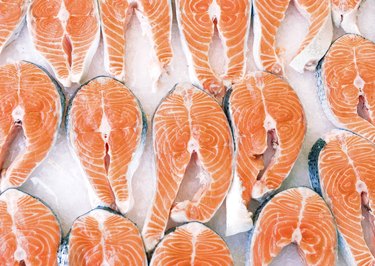
Salmon, rich in omega-3 fatty acids and a lean source of protein, is a worthy addition to a healthy diet. Available fresh or frozen, whole or filleted, the fish cooks quickly on the stovetop or in the oven. If you want to defrost it though, you have some options for how to make that happen.
Defrosting Salmon
Video of the Day
The ideal way to thaw frozen salmon is in the refrigerator. It's easy, and you don't have to worry about bacterial growth because the fish will be at a safe temperature throughout the thawing process. Most fish will thaw overnight. Salmon thawed in the refrigerator will keep for two days.
Video of the Day
If you're in a hurry, defrost salmon in cold water. Transfer the frozen fish to a watertight plastic bag and submerge it in cold water. Change the water every half-hour. It should take less than an hour to thaw a pound of fish. A 3- or 4-pound fish may take up to three hours to defrost. You'll know it's thawed if the flesh "gives" when you press on it. Cook the fish immediately after thawing.
As a last resort, you can thaw fish in the microwave, but you must cook it as soon as it's thawed. Keep in mind that thinner parts of fish fillets thaw more quickly than thick parts and may start to cook before the fish is completely thawed. Check your microwave's manual for defrosting times.
If the fish was vacuum sealed, remove it from the packaging before thawing. Bacteria present in vacuum-packed fish can grow in the packaging during the thawing process.
Salmon Cooking Methods
As a general rule, plan on 8–10 minutes of cooking time for each inch of thickness, but this rule isn't hard and fast. The recipe, the temperature of the cooking method and the size of the fish are all variables. The internal temperature of well-done salmon should be 145 degrees Fahrenheit.
Pan searing. Heat a heavy pan over high heat; then add enough vegetable oil to just coat the bottom of the pan. Put the fish skin-side down in the pan and press it down with a spatula. Cook the salmon without turning for about 3 minutes or until the color starts to change along the sides almost to the top. Turn off the heat, remove the pan from the burner, and flip the fish.
Baking or roasting. Heat the oven to 450F. Season the salmon with salt and pepper and put it skin-side down on a nonstick baking sheet. Bake for 12 to 15 minutes, depending on the size of the fish.
Poaching. Use stock or create a poaching liquid by sauteing carrots, celery and onion until they're softened. Add enough water to the vegetables to cover the fish. Simmer the liquid for a few minutes; then add the salmon. Cover and cook over low heat for about 8 minutes.
Cooking in parchment. Salmon en papillote is seasoned, then loosely wrapped in parchment paper before baking for about 15 minutes at 400F.
Frozen Salmon Tips
- When purchasing frozen salmon, look for ice crystals or frost on the fish or the packaging. If they're present, the fish has been frozen for a long time, or it may have thawed and been refrozen, making it less palatable. Make sure the fish is frozen solid.
- Bring the salmon to room temperature before cooking.
- Defrosting fish before cooking isn't required, but starting from frozen will add about 50 percent to the cook time.
- Test the doneness of the fish by sliding the tip of a knife into the center and pushing it gently to the side. The interior should be almost opaque. Remove the salmon from the heat and let it rest. The internal temperature rises during resting due to residual heat.
- Don't overcook salmon. It will dry out and toughen.
- Use frozen salmon within four to six months of purchase.
-
- USDA: The Big Thaw – Safe Defrosting Methods for Consumers
- USDA: Keep Food Safe! Food Safety Basics
- MSU Extension: Open Your Vacuum Packed Fish Before Thawing
- USDA: Safe Minimum Internal Temperature Chart
- Minnesota Sea Grant: Cooking Your Catch
- University of Minnesota Extension: How to Avoid Fishy Tasting Fish
- Bon Apetit: Learn How to Cook Salmon by Avoiding These 6 Common Mistakes
- Mayo Clinic: Cooking Fish